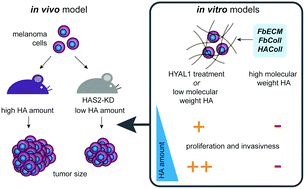当前位置:
X-MOL 学术
›
Biomater. Sci.
›
论文详情
Our official English website, www.x-mol.net, welcomes your feedback! (Note: you will need to create a separate account there.)
Biomimetic tissue models reveal the role of hyaluronan in melanoma proliferation and invasion.
Biomaterials Science ( IF 6.6 ) Pub Date : 2020-01-15 , DOI: 10.1039/c9bm01636h Jiranuwat Sapudom 1 , Khiet-Tam Nguyen , Steve Martin , Tom Wippold , Stephanie Möller , Mathias Schnabelrauch , Ulf Anderegg , Tilo Pompe
Biomaterials Science ( IF 6.6 ) Pub Date : 2020-01-15 , DOI: 10.1039/c9bm01636h Jiranuwat Sapudom 1 , Khiet-Tam Nguyen , Steve Martin , Tom Wippold , Stephanie Möller , Mathias Schnabelrauch , Ulf Anderegg , Tilo Pompe
Affiliation

|
Interactions of hyaluronan (HA) and tumor and stromal cells are highly discussed as one of the major contributors in tumor progression and metastasis. The balance of HA in the tissue is highly regulated by two key enzyme classes; hyaluronan synthases (HAS) and hyaluronidases (HYAL). Current reports hint that the HA amount in the tissue is correlated with poor prognosis in melanoma, the most life-threatening skin tumor. In this work, we generated in vivo mouse models with low and high expression of Has2 and used the models for studying melanoma proliferation of the B78D14 melanoma cell line. We found that a strong reduction of HA amount in the skin was correlated to decreased tissue stiffness and a reduction in tumor weight. Since tumor cells have a direct contact to the HA in the tumor and at the stroma interface, we reconstituted different biomimetic in vitro models using fibroblasts derived from a mouse model to recapitulate melanoma cell behavior at the tumor boundary, namely, (i) decellularized fibroblast matrix (FbECM), (ii) fibroblast embedded into 3D collagen matrices (FbColl), and (iii) well-defined HA-functionalized 3D collagen matrices (HAColl). We found no considerable effect of high and low amounts of fibroblast-derived HA in the matrices on melanoma proliferation and invasion. However, HYAL1-treated FbECM and FbColl, as well as HAColl functionalized with low molecular weight HA (34 kDa) promoted proliferation and invasion of melanoma cells in a concentration dependent manner. Our results emphasize the molecular weight specific effects of HA in regulation of melanoma behavior and provide an alternative explanation for the in vivo observation of HA dependent tumor growth.
中文翻译:

仿生组织模型揭示了透明质酸在黑色素瘤增殖和侵袭中的作用。
透明质酸(HA)与肿瘤和基质细胞的相互作用已被广泛讨论为肿瘤进展和转移的主要因素之一。组织中HA的平衡受到两个关键酶类别的高度调控。透明质酸合酶(HAS)和透明质酸酶(HYAL)。当前的报道提示,组织中的HA含量与最致命的皮肤肿瘤黑素瘤的预后不良有关。在这项工作中,我们生成了具有低和高表达Has2的体内小鼠模型,并将该模型用于研究B78D14黑色素瘤细胞系的黑色素瘤增殖。我们发现,皮肤中HA含量的强烈降低与组织刚度降低和肿瘤重量减少有关。由于肿瘤细胞与肿瘤中和基质界面上的HA直接接触,我们使用源自小鼠模型的成纤维细胞重构了不同的仿生体外模型,以概括肿瘤边界处的黑色素瘤细胞行为,即(i)去细胞成纤维细胞基质(FbECM),(ii)嵌入3D胶原基质(FbColl)中的成纤维细胞,以及(iii)定义明确的HA功能化3D胶原蛋白基质(HAColl)。我们发现基质中大量和少量成纤维细胞衍生的HA对黑色素瘤的增殖和侵袭没有显着影响。然而,HYAL1处理的FbECM和FbColl以及低分子量HA(34 kDa)功能化的HAColl以浓度依赖的方式促进了黑素瘤细胞的增殖和侵袭。
更新日期:2020-03-03
中文翻译:

仿生组织模型揭示了透明质酸在黑色素瘤增殖和侵袭中的作用。
透明质酸(HA)与肿瘤和基质细胞的相互作用已被广泛讨论为肿瘤进展和转移的主要因素之一。组织中HA的平衡受到两个关键酶类别的高度调控。透明质酸合酶(HAS)和透明质酸酶(HYAL)。当前的报道提示,组织中的HA含量与最致命的皮肤肿瘤黑素瘤的预后不良有关。在这项工作中,我们生成了具有低和高表达Has2的体内小鼠模型,并将该模型用于研究B78D14黑色素瘤细胞系的黑色素瘤增殖。我们发现,皮肤中HA含量的强烈降低与组织刚度降低和肿瘤重量减少有关。由于肿瘤细胞与肿瘤中和基质界面上的HA直接接触,我们使用源自小鼠模型的成纤维细胞重构了不同的仿生体外模型,以概括肿瘤边界处的黑色素瘤细胞行为,即(i)去细胞成纤维细胞基质(FbECM),(ii)嵌入3D胶原基质(FbColl)中的成纤维细胞,以及(iii)定义明确的HA功能化3D胶原蛋白基质(HAColl)。我们发现基质中大量和少量成纤维细胞衍生的HA对黑色素瘤的增殖和侵袭没有显着影响。然而,HYAL1处理的FbECM和FbColl以及低分子量HA(34 kDa)功能化的HAColl以浓度依赖的方式促进了黑素瘤细胞的增殖和侵袭。



























 京公网安备 11010802027423号
京公网安备 11010802027423号